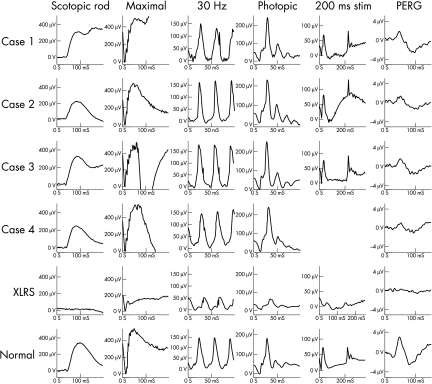Foveal or macular retinoschisis is an uncommon retinal disorder, usually seen in patients affected with generalised retinal disease such as X linked retinoschisis,1 Goldmann-Favre syndrome,2 and enhanced S-cone syndrome.3 There have been a handful of previous reports of patients exhibiting foveal retinoschisis in whom there appeared to be limited concomitant peripheral retinal disease,4–6 suggesting the existence of a distinct disorder. We report the clinical findings in four female patients presenting with a reduction in central acuity and exhibiting isolated bilateral foveal retinoschisis, and investigations including scanning laser ophthalmoscopy (SLO) autofluorescence imaging, optical coherence tomography (OCT), and electrophysiology.
Case reports
Case 1
A 17 year old girl presented with bilateral reduction in central vision. With refraction (+0.50DS right, +0.25DS left) her visual acuity was 6/18. On examination the only abnormal finding was thickening of the neurosensory retina at the fovea with a radial pattern of striae bilaterally. There was no leakage suggestive of macular oedema on fluorescein angiography.
Cases 2 and 3
Female dizygotic twins 19 years of age both reported a mild non-progressive reduction in their central vision. Best corrected visual acuities ranged from 6/12 to 6/18. On examination the only abnormal finding was thickening of the neurosensory retina at the foveal retina in all four eyes. Fluorescein angiography showed no evidence of macular oedema.
Case 4
A 22 year old girl presented with difficulties for near vision over the previous 4 years. Best corrected visual acuity was 6/12 with each eye with a small hyperopic correction. The only abnormal findings on ophthalmoscopy were fine cystoid retinal changes at both foveae and small areas of retinal pigment epithelium (RPE) depigmentation at the maculae. Fluorescein angiography showed small areas of transmission defect with increased fluorescence within the foveal avascular zone of both eyes; there was no leakage suggestive of macular oedema.
In none of the three families was there any family history of eye disease. Moreover, the six parents were examined and all found to have normal acuities and retinal macula appearance. The results of SLO autofluorescence imaging and OCT imaging are shown in Figure 1. In all cases, there was a radial hyperautofluorescence at the central macula, within an otherwise uniform normal retinal signal. The splitting of the neurosensory layer at the central macula was confirmed on OCT imaging. The ganzfeld ERGs were normal and the pattern electroretinogram (PERG) subnormal in amplitude in all four patients (Fig 2).
Figure 1.
A prototype Zeiss confocal scanning laser ophthalmoscope (SLO) recorded autofluorescence images using argon laser blue light and a broadband pass barrier filter with a short wavelength cut off at 521 nm. Single line bilaminar scans of the macular retina were performed using the OCT 2000 scanner (Zeiss Humphrey Instruments, San Leadro, CA, USA).
Figure 2.
Full field electroretinogram (ERG) and pattern ERG were recorded using standardised methods according to International Society for Clinical Electrophysiology of Vision (ISCEV) standards. Long duration photopic stimulation was performed to separate ON and OFF photopic pathways.
Comment
All four patients have localised central retinal disease as confirmed by electrophysiology, and are therefore distinct from those cases with generalised retinal disorders listed above, as well as the reported families with inherited macular oedema.7 Similarly, they are unlikely to be manifesting homozygotes, or XO cases of X linked retinoschisis. The morphology of the central retina in each of the cases does seem to be identical to the findings in hemizygotes affected by X linked retinoschisis.8
Instead, these cases closely resemble clinically the patients described by Lewis et al4 and Lorenz et al.5 When viewed collectively it is likely that this disorder is autosomal recessive in inheritance. It is of interest that all eight cases are female. This might represent a chance finding (this is unlikely: p = 0.016, considering the identical twins in the report by Lewis et al4 as one case), a real underlying sex difference in the prevalence of this rare condition, or the under-reporting of similar male cases as a result of their assignment to a diagnosis of XLRS. There are a few other cases in the literature demonstrating a similar foveal appearance with minimal peripheral changes6, 9, 10 which may be manifesting a different disorder. It is very difficult to predict the long term prognosis for our patients, as such cases are rare and longitudinal data are unavailable. Future genetic analysis, such as screening for novel mutations in NR2E3, the gene responsible for enhanced S-cone syndrome, may shed light on the aetiology of this rare disorder.
References
- 1.George ND, Yates JR, Moore AT. Clinical features in affected males with X-linked retinoschisis. Arch Ophthalmol 1996;114:274–80. [DOI] [PubMed] [Google Scholar]
- 2.Fishman GA, Jampol LM, Goldberg MF. Diagnostic features of the Favre-Goldmann syndrome. Br J Ophthalmol 1976;60:345–53. [DOI] [PMC free article] [PubMed] [Google Scholar]
- 3.Marmor MF, Jacobson SG, Foerster MH, et al. Diagnostic clinical findings of a new syndrome with night blindness, maculopathy, and enhanced S cone sensitivity. Am J Ophthalmol 1990;110:124–34. [DOI] [PubMed] [Google Scholar]
- 4.Lewis RA, Lee GB, Martonyi CL, et al. Familial foveal retinoschisis. Arch Ophthalmol 1977;95:1190–6. [DOI] [PubMed] [Google Scholar]
- 5.Lorenz B, Gerth C, Bock M, et al. Isolated foveal retinoschisis in a 7-year-old girl. Invest Ophthalmol Vis Sci 2000;41:S883. [Google Scholar]
- 6.Perez Alvarez MJ, Clement Fernandez F. [No X-chromosome linked juvenile foveal retinoschisis.] Arch Soc Esp Oftalmol 2002;77:443–8. [PubMed] [Google Scholar]
- 7.Deutman AF, Pinckers AJLG, Aan de Kerk AL. Dominantly inherited cystoid macular oedema. Am J Ophthalmol 1976;82:540–8. [DOI] [PubMed] [Google Scholar]
- 8.Stanga PE, Chong NHV, Reck AC, et al. Optical coherence tomogrophy (OCT) and electrophysiology in X-linked juvenile retinoschis associated with a novel mutation in the XLRS1 gene. Retina 2001;21:78–80. [DOI] [PubMed] [Google Scholar]
- 9.Han DP, Sieving PA, Martonyi CRA. Foveal retinoschisis associated with senile retinoschisis in a woman. Am J Ophthalmol 1988;106:107–9. [DOI] [PubMed] [Google Scholar]
- 10.Shimazaki J, Matsuhashi M. Familial retinoschisis in female patient. Doc Ophthalmol 1987;65:393–400. [DOI] [PubMed] [Google Scholar]




